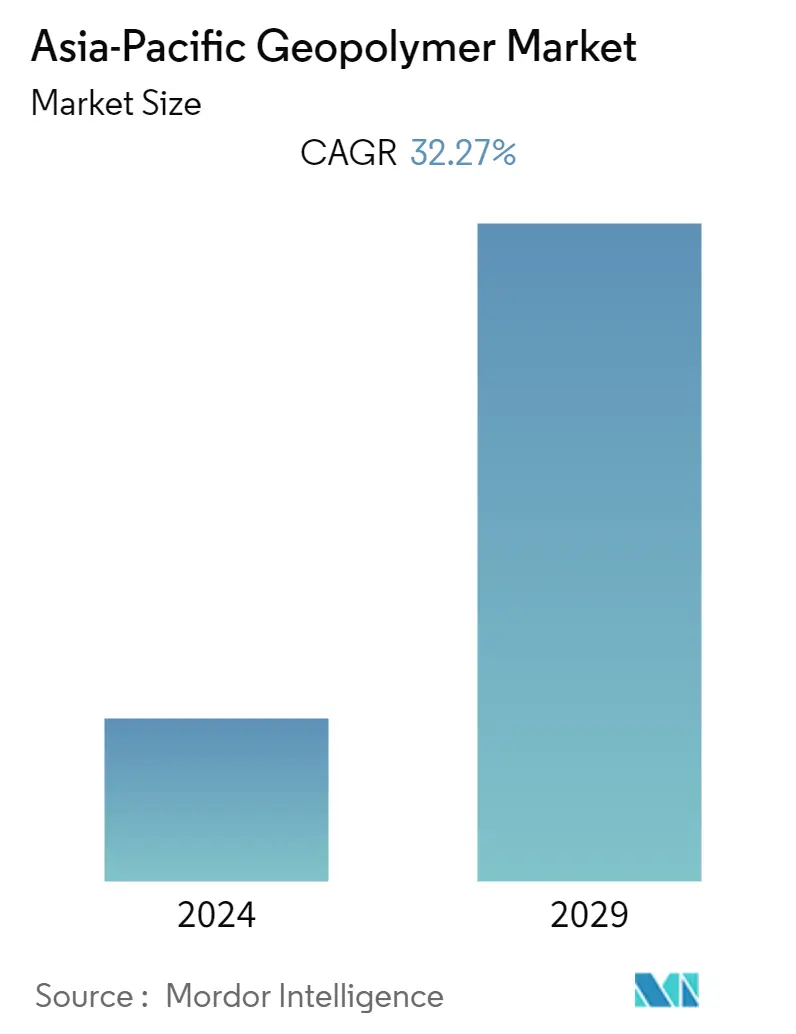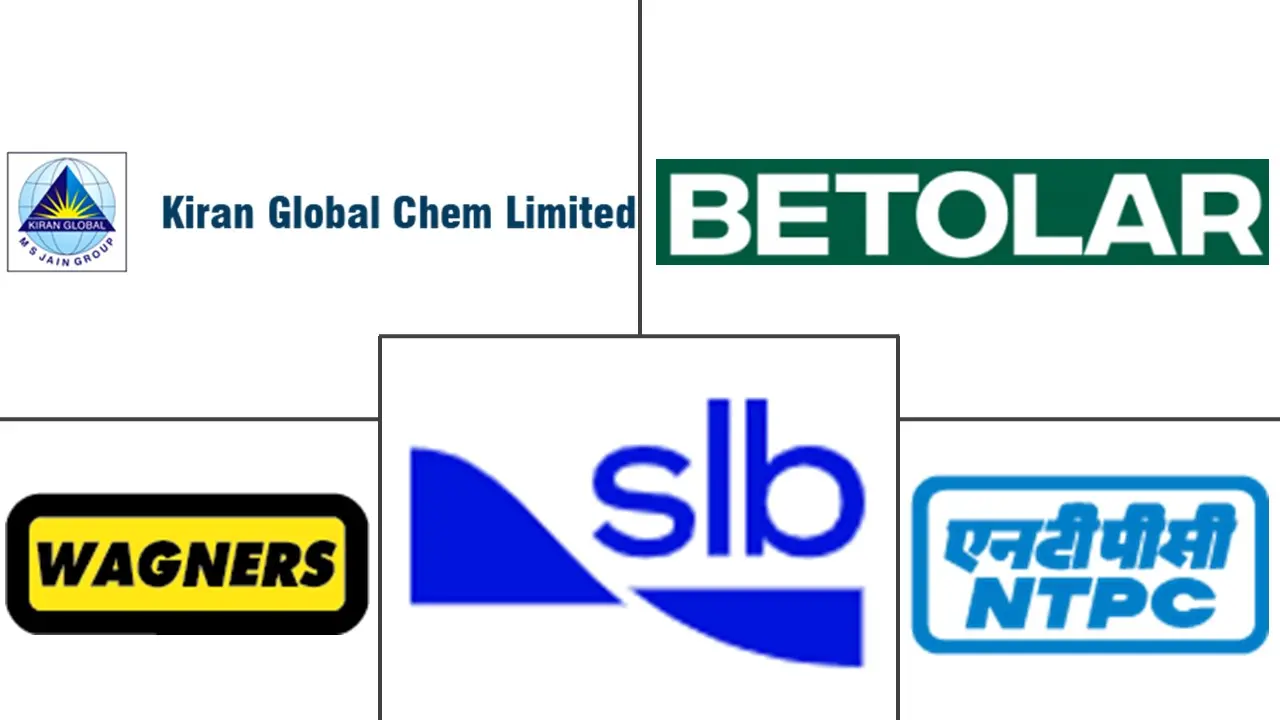Market Size of Asia-Pacific Geopolymer Industry

| Study Period | 2019 - 2029 |
| Base Year For Estimation | 2023 |
| Forecast Data Period | 2024 - 2029 |
| Historical Data Period | 2019 - 2022 |
| CAGR | 32.27 % |
| Market Concentration | High |
Major Players
*Disclaimer: Major Players sorted in no particular order |
Asia-Pacific Geopolymer Market Analysis
The Asia-Pacific geopolymer market is estimated to reach USD 6.60 billion by the end of this year. It is projected to reach USD 26.71 billion in the next five years, registering a CAGR of 32.27% during the forecast period.
The market was negatively impacted by COVID-19 since there were no construction activities during the pandemic, and the manufacturing factories were in complete shutdown. Construction industry professionals, including civil engineers, architects, and contractors, could not resume work due to the consequences of lockdowns. Currently, the market recovered from the pandemic and is growing at a significant rate.
- The environmental regulations concerning the emissions from the cement industry and increasing investments in the construction industry are major factors driving the studied market's growth.
- However, the lack of awareness of the benefits of geopolymer will likely restrain the studied market's growth.
- Nevertheless, effectively utilizing industrial by-products/waste to manufacture geopolymer will likely create lucrative growth opportunities in the Asia-Pacific market.
- China represents the largest market over the forecast period due to the substantial scope for the demand for geopolymer-based products from the domestic construction industry.
Asia-Pacific Geopolymer Industry Segmentation
A geopolymer is an amorphous semi-crystalline material produced by the polymerization of an aluminosilicate source and an alkaline reagent. The study of geopolymers primarily focuses on building materials. Technology is being created to discover more environment-friendly alternatives to Portland cement that creates concrete, bricks, etc. Their ability to be produced using by-products from other industries is a huge advantage. The best-known example is fly ash from coal-fired power plants.
The Asia-Pacific geopolymer market is segmented by product type, application, and geography. The market is segmented by product type into cement, concrete, precast panel, grout and binder, and other product types (composites, foam, and bricks). The market is segmented by application into building, road and pavement, runway, pipe and concrete repair, bridge, tunnel lining, railroad sleeper, coating application, fireproofing, nuclear and other toxic waste immobilization, and specific mold products. The report also covers the market size and forecasts for the Asia-Pacific geopolymer market for 5 major countries. For each segment, the market sizing and forecasts are provided in value (USD).
| Product Type | |
| Cement, Concrete, and Precast Panel | |
| Grout and Binder | |
| Other Product Types (Composites, Foam, and Bricks) |
| Application | |
| Building | |
| Road and Pavement | |
| Runway | |
| Pipe and Concrete Repair | |
| Bridge | |
| Tunnel Lining | |
| Railroad Sleeper | |
| Coating | |
| Fireproofing | |
| Nuclear and Other Toxic Waste Immobilization | |
| Specific Mold Products |
| Geography | |
| China | |
| India | |
| Japan | |
| South Korea | |
| ASEAN Countries | |
| Rest of Asia-Pacific |
Asia-Pacific Geopolymer Market Size Summary
The Asia-Pacific geopolymer market is experiencing significant growth, driven by the increasing demand for sustainable construction materials and the region's rapid urbanization. The market, which had faced setbacks due to the COVID-19 pandemic, has rebounded and is expanding at a robust pace. Key factors propelling this growth include stringent environmental regulations on cement emissions and substantial investments in the construction sector. Geopolymers, known for their high compressive strength and low environmental impact, are becoming increasingly popular in building construction, particularly in countries like China and India, where urbanization and population growth are fueling the need for housing and infrastructure. Despite challenges such as limited awareness of geopolymer benefits, the use of industrial by-products in geopolymer production presents promising opportunities for market expansion.
China stands out as the dominant player in the Asia-Pacific geopolymer market, supported by its vast construction activities and government initiatives aimed at urbanization and infrastructure development. The country's ambitious plans, including the construction of new megacities and extensive transportation networks, are expected to drive significant demand for geopolymer-based products. Additionally, the growing disposable income in China is spurring the development of commercial spaces, further boosting the market. Other countries in the region, such as India and Australia, are also contributing to market growth through initiatives to enhance housing availability and reduce CO2 emissions in construction. The market is characterized by a consolidated landscape with key players like Wagners, Kiran Geopolymer, NTPC, SLB, and Betolar Plc, who are actively innovating and expanding their presence in the region.
Asia-Pacific Geopolymer Market Size - Table of Contents
-
1. MARKET DYNAMICS
-
1.1 Drivers
-
1.1.1 Environmental Regulations Concerning Emissions from the Cement Industry
-
1.1.2 Increasing Investments in the Construction Industry
-
1.1.3 Other Drivers
-
-
1.2 Restraints
-
1.2.1 Lack of Awareness of Benefits of Geopolymer
-
1.2.2 Other Restraints
-
-
1.3 Industry Value-Chain Analysis
-
1.4 Porter's Five Forces Analysis
-
1.4.1 Bargaining Power of Suppliers
-
1.4.2 Bargaining Power of Buyers
-
1.4.3 Threat of New Entrants
-
1.4.4 Threat of Substitute Products and Services
-
1.4.5 Degree of Competition
-
-
-
2. MARKET SEGMENTATION (Market Size in Value)
-
2.1 Product Type
-
2.1.1 Cement, Concrete, and Precast Panel
-
2.1.2 Grout and Binder
-
2.1.3 Other Product Types (Composites, Foam, and Bricks)
-
-
2.2 Application
-
2.2.1 Building
-
2.2.2 Road and Pavement
-
2.2.3 Runway
-
2.2.4 Pipe and Concrete Repair
-
2.2.5 Bridge
-
2.2.6 Tunnel Lining
-
2.2.7 Railroad Sleeper
-
2.2.8 Coating
-
2.2.9 Fireproofing
-
2.2.10 Nuclear and Other Toxic Waste Immobilization
-
2.2.11 Specific Mold Products
-
-
2.3 Geography
-
2.3.1 China
-
2.3.2 India
-
2.3.3 Japan
-
2.3.4 South Korea
-
2.3.5 ASEAN Countries
-
2.3.6 Rest of Asia-Pacific
-
-
Asia-Pacific Geopolymer Market Size FAQs
What is the current Asia-Pacific Geopolymer Market size?
The Asia-Pacific Geopolymer Market is projected to register a CAGR of 32.27% during the forecast period (2024-2029)
Who are the key players in Asia-Pacific Geopolymer Market?
Wagners, Kiran Geopolymer, NTPC (National Thermal Power Corporation), SLB (Schlumberger Limited) and Betolar Plc are the major companies operating in the Asia-Pacific Geopolymer Market.

